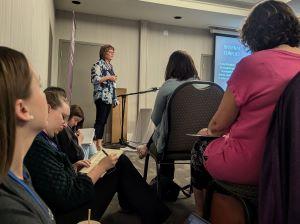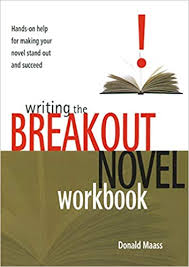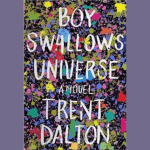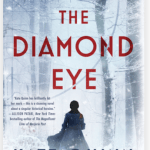
Since I have both a daughter and a writer-friend in Calgary, this year I decided to attend When Words Collide. This annual conference grew out of a gathering of sci-fi and fantasy writers many years ago. Now there are over 800 writers of all stripes who attend, and dozens of sessions about all aspects of the writing craft. I even managed to find another author writing historical fiction about Russian radicals, although her era is set a century before Red Rules, the book I’m writing.
Here are highlights of my notes from the conference, including tidbits that may interest even the non-writers among you.
Table of Contents
Crime to Courtroom – Dave Sweet

Former detective David Sweet walked us through the process of murder investigations, using the example of an actual case from 2014 of a five year-old and his grandparents who went missing. Sweet was part of a large team that ultimately identified the killer, Douglas Garland.
Among the tidbits I picked up from his presentation:
- Only ¼ of people who choose to end their lives by suicide leave a note.
- Almost every drug death is declared “undetermined” because we don’t know if it was an accidental drug poisoning, suicide, or even drug administered to them by someone wanting to kill them.
- If you are walking by a house and notice a lot of flies in the window, there’s very likely a dead body in there.
- To create an Amber Alert for a missing person there must be a suspect. How frustrating that must be for people whose friends or family members have vanished with no obvious suspects.
- Even in Canada, about 70% of the time some aspect of the crime is caught on video (e.g. vehicle fleeing, suspect entering the area, etc.) The growth of video doorbells is helping that number skyrocket. The porch pirate stealing your Amazon delivery may not be of interest to the police, but the green truck driving by in the background may be.
- There can be interesting roundabout ways to determine time of death. For instance, in one case there was paint on the back of the victim’s jacket, and also an empty spray paint can at the scene. The paint would have to have been wet when it got on the victim’s jacket. They contacted the paint manufacturer to find out how long that type of paint would take to dry, which gave them an idea of when the victim would must have come in contact with it.
- To the unskilled eye, a process called “lividity” can be confused with bruising on a victim’s body. After death, gravity pulls the blood in the body to the body parts closest to the ground, which turn purplish/red. White blotches in the livid areas can indicate that, for example, the body had been sitting or leaning against something because the parts in contact with the chair or wall would stay white.
- Search warrants are complicated and have to be written carefully. If there is a good reason to believe there’s a person in danger on a property, though, it can be legal for police to enter without one. In the Garland case, the medical examiner said the amount of blood found at the scene from where the victims had disappeared wasn’t enough to conclude that all three were dead. So when police had identified a suspect they did not need a warrant to enter his premises and search for them. Sadly, it turned out they were all dead.
- If you are interested in true crime and police investigations, Sweet recommends the podcast, The Ride Along, and he feels that Brooklyn Nine-Nine is the most realistic show.
David Sweet’s website: https://www.unconventionalclassroom.ca/
Realistic Fight Scenes – Ron Bender

Still on the theme of violence and death, here are a few interesting details from Ron Bender, author of the New White Sands City Cyberpunk series.
- 4 joules of energy with a knife is enough to penetrate skin and muscle. 85 joules to the head or spine with a bullet will kill. Today’s handguns release a minimum of 500 joules when shot.
- In the real world, most gun fights happen at night in poor lighting conditions. Despite most shooters being less than 28 feet away from their targets and shooting 30 rounds, there’s no fatality. In other words, most potential victims are running away in the dark. If you are doing that, you’ve got a good chance of survival.
Ron Bender’s website: https://thecyberdeck.com/
Writing Sex Scenes – Sarah L. Pratt

There are many similarities between writing realistic fight scenes and sex scenes. In both cases you have to think about the limits of how human body parts can actually move. You have to decide how much your reader can take with regards to descriptions of anatomy and bodily fluids. You need to combine descriptions of the physical and the emotional. Most importantly, you have to really know your characters, so that whatever you describe them experiencing rings true.
Just like sex in the real world, sex scenes generally work best if you’ve given the reader time to get to know the characters first, then time for the relationship to develop and the sexual tension to build before you climax with sex.
Sarah Pratt’s website: https://the-seventh-terrace.com/contact/
Internal Conflict – Angela Ackerman

This was the first of Angela’s two massively over-subscribed sessions at When Words Collide. Even though I’ve referred to her Emotion Thesaurus often in writing Red Rules, I thought I’d squeeze my way into a spot at the feet of the guru and see if I could learn something beyond the book from her session. I did.
For one thing, I realized that my protagonist always makes “the right” decision. He may hesitate, and occasionally stumble a bit as he figures out what the right decision is, but I don’t think I’ve ever had him make the wrong decision. This can be tricky, because you don’t want your reader getting annoyed with your characters for making bad decisions, but since the point of a novel is for your character to learn and grow, there are bound to be some bad decisions along the way. So you have to write the character’s inner struggles well enough that it is credible when they make bad decisions. They will learn from them eventually.
I also realized that, while I do have my protagonist debating (often) what is the right course of action and struggling with moral dilemmas, there are many ways of showing that inner turmoil and I’ve only used a few of them. What about having him snap at someone he loves, appear distracted, or stop caring about personal cleanliness?
How to Amplify Characters’ Emotional Responses – Angela Ackerman

Angela Ackerman and her writing partner, Becca Puglisi, have written a series of incredible reference books for authors. Their first (and probably top selling) was The Emotion Thesaurus. Pick an emotion, any emotion, and they’ll tell you what are the inward and outward signs that the character is experiencing it. Apparently almost all authors struggle to avoid using the same emotional descriptions for their characters all the time. Whether it’s an upset character digging their fingernails into their fists so hard they draw blood (does anyone actually do that?) or a fluttering heart, you sometimes need help to get beyond the obvious and increase variety.
They eventually realized there were some characteristics that were not emotions in themselves, but would make one’s reactions more emotionally extreme. Pain, hunger, fatigue, sexual arousal are just a few examples. When I’m hangry I get impatient. I snap at my DH (Darling Hubby. Took a long time for him to realize that he does the same to me when he’s hangry).
Even states like boredom can amplify emotions and lead to worse behaviour, says Ackerman: you are more likely to act out and do stupid things just to make life more interesting. (I remember the smart, bored, kid in a high school class I taught years ago who kept pushing the not-so-smart football player to do disruptive things. It was smarty pants I needed to work on, not the jock.)
Emotional amplifiers can cause three types of strain:
- Cognitive – makes it harder for the character to think things through because their emotions are so activated
- Psychological/Emotional – mood, mental fatigue; may be blaming themselves afterwards for why they blew up and acted out of proportion
- Physical – withdrawal symptoms, less endurance, less energy, headaches, etc.
I’ve added the Emotional Amplifiers Thesaurus to my collection of their books.
Triggers, Trauma & Secret Shame – Finnian Burnett

Author and English professor, Finn Burnett discussed how we can tap into the triggers and traumas of our characters to make them more complex and believable. Burnett urged us to consider all aspects of our characters’ personal identities and how those aspects might interact with each other to shape the characters and how they act.
So don’t just think about your character’s height, hair and eye colour. In fact, those are often not even worth mentioning. Instead, mention what makes them unique. What shapes their behaviour and how people perceive them.
What about their sexual identity (and are they hiding it), their chronic health issues that could influence their behaviour, their past traumas that lie buried but could burble to the surface, … The possibilities are endless.
Finn Burnett’s website: https://finnburnett.com/
Pacing: Scene & Sequel – Jaima Fixsen

In his 1965 book, Techniques of the Selling Writer, Dwight Swain described scenes as units that include a goal, a conflict and a disaster. Each such scene is followed by what he called a “sequel”, which consists of a reaction to what happened, a dilemma and a decision. That leads into the next goal-conflict-disaster scene. In this session Jamia Fixsen took us through Swain’s approach, reminding us that every bit of a story has to be connected to what follows.
Go through your manuscript, she urged, making sure you are following these patterns. Flag the character’s reactions and note if any are missing. When it comes to conflicts and dilemmas, look to see if you can make them bigger or more meaningful to the reader.
She suggested using different highlighters to flag the goals, conflicts, and disasters. In each scene/sequel,
- Is your character’s goal clear to the reader?
- What do you learn about your character from the conflict? Highlight their actions or responses that reveal their skills, quirks, personality, etc.
- Does the conflict build or fizzle?
- Examine your disaster: find the unexpected info, the setback that happens just when things are looking good. If it’s not there, brainstorm what could be there and write it in the margins as you do your read-through. Remember: disaster is a hook leading into the next scene.
Jaima Fixen’s website: jaimafixsen.com
Writing Short Fiction – Premee Mohamed

Edmonton Public Library’s current Writer in Residence, Premee Mohamed, spoke about writing short fiction. You don’t have time to get past first impressions in short stories, so elements like the title and intro hook are even more important than they are in novels.
You want your title to be memorable. Often it will give a clue as to genre and premise of the story. If you possibly can, have it mean one thing at the start and something else at the end.
The entry hook must evoke curiosity and raise interesting questions. It tells us about the tone/atmosphere/style of writing we can expect and it orients us to the context of the story. In longer fiction you can start with establishing the “everyday life” pattern; in short fiction you’ll typically start when that pattern is broken.
She suggested using the notion of MICE: milieu, investigation, character, and event. Although most stories touch on all those elements, you wan to focus on just one of them for a short story. A milieu story might focus on someone who wants to escape their restrictive life in a small Alberta town. An investigation-focused story would be about someone lacking key knowledge and their struggle to get it. Character-based stories are about someone who wants or needs to change something about their nature. Event-focused stories are typically about trying to prevent something bad from happening or dealing with something big that has happened.
When it comes to endings, think about:
- How do you want to leave the reader feeling?
- Is your ending narratively and emotionally logical: the character’s choices and consequences led to this ending (it makes sense, but is still surprising)
- Are all open MICE tags closed?
- Have the characters acted consistently within their story world? (No, my protagonist in 1919 Siberia couldn’t phone his lover to warn her of danger.)
Fiction writing generally pays poorly, and short fiction possibly even more so. But it can be a way to get your name out there and build some literary cred before you approach an agent or publisher. But don’t, Premee stressed, pay submission or reading fees! There are enough legitimate publications out there that don’t charge them, and there’s really no excuse for doing so, she says.
Premee Mohamed’s website: premeemohamed.com
Pre-conference session on Comparables – Sam Hiyate

Many writers struggle with “comps” but they are an essential part of selling your book to agents and publishers. They need to know what your book is similar to so they know how to position it to find the most readers.
Don’t fall into the trap of thinking you have no comps. If your book is completely different from anything else ever written it’s not likely to sell – to agents or readers. (It’s also probably unreadable.) People want a level of familiarity, but with a unique take on the stories we’ve been telling for millennia. Know what makes your work similar as well as what makes it distinctive.
There’s conflicting advice out there about how to choose the right comps. A week before the conference, for instance, I listened to a speaker insist that your comps had to be books that had been released within the past two years. Bunk! says agent and former publisher, Sam Hiyate. He read us a selection of comps that were used to sell books this month, some for six-figure advances. For example:
- Pirates of the Caribbean meets Jane Eyre
- A black, southern, Godfather
- Oceans 11 meets the Golden Girls
- Does for Halloween what The Grinch did for Christmas
Not only are many of these references not recent, many refer to movies or TV shows rather than books. The reality is that even the bookish among us have generally seen more movies and TV shows than we have read books. So not only will you be more likely to hit on a comp that your prospective agent or publisher is familiar with that way, the big money these days is in selling movie or TV rights to a novel, not in the novel itself. Novelists I spoke to at the conference told me they’d made more on selling tv or movie rights to one novel than they had on the sale of a dozen novels to well-known publishers. That holds true even if the show never gets made.
Sam’s other interesting point was that you can use this type of ‘x meets y’ analysis to help you spot ideas for books that haven’t been written yet, or get a clearer sense of where your idea fits in the market. You may not be able to write as well as J.K. Rowling, but one author looked at the success of Harry Potter and realized that he could take her idea but set it at a college level so the protagonists could drink and have sex. Ba-boom! As Austin Kleon’s book says, “Steal Like an Artist.”
Sam Hiyate’s website: https://www.therightsfactory.com/Agents/sam-hiyate
This was only a small sampling of the dozens of sessions on offer at the conference. But now it’s time for me to get back to my art.





Thanks Angela. I didn’t get to meet you in person, but hope to at some point in the future!
Love this recap – it looks like you went to some amazing sessions that I missed! And I’m so glad you were able to pull some takeaways from my sessions. Thanks so much for the kind words, and for all the pictures!
See you next year!
Angela